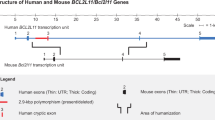Abstract
Necdin (Ndn) transgenic (Tg) mice were generated with a bacterial artificial chromosome (BAC) clone. Droplet digital PCR (ddPCR) and inverse PCR methods revealed that the transgene consisted of four fragments with a total length of 171 kb. Two of these fragments were tandem tail-to-tail duplicates of 77 kb and 37 kb that both contained a Ndn gene. The transgene was inserted in chromosome 15qD1. Ndn is a paternally expressed imprinted gene; however, the total expression level of Ndn in hemizygous Tg mice was approximately twofold higher than that in wild-type mice. ddPCR assays with locked nucleic acid (LNA) TaqMan probes revealed that transgenic Ndn expression was almost equal to endogenous Ndn expression, despite there being two copies of the Ndn gene in the transgene, indicating an interaction between the transcriptional regulation of endogenous Ndn and the transgene. ddPCR assays with LNA TaqMan probes were also applied for imprinting analysis to confirm exclusive paternal expression in tissues with low Ndn expression. This is the first report of a Tg mouse with a tandem duplication of a Ndn transgene and Ndn overexpression, which will be useful for the in vivo study of Ndn overexpression and for rescue experiments of the neonatal lethality seen in the Ndn knockout mouse.






Similar content being viewed by others
References
Hanel ML, Wevrick R (2001) Establishment and maintenance of DNA methylation patterns in mouse Ndn: implications for maintenance of imprinting in target genes of the imprinting center. Mol Cell Biol 21:2384–2392
Hindson BJ et al (2011) High-throughput droplet digital PCR system for absolute quantitation of DNA copy number. Anal Chem 83:8604–8610
Jensen GA, Singh SK, Kumar R, Wengel J, Jacobsen JP (2001) A comparison of the solution structures of an LNA:DNA duplex and the unmodified DNA:DNA duplex. J Chem Soc Perkin Trans 2:1224–1232
Johnson MP, Haupt LM, Griffiths LR (2004) Locked nucleic acid (LNA) single nucleotide polymorphism (SNP) genotype analysis and validation using real-time PCR. Nucleic Acids Res 32:e55. https://doi.org/10.1093/nar/gnh046
Koshkin AA, Nielsen P, Meldgaard M, Rajwanshi VK, Singh SK, Wengel J (1998) LNA (locked nucleic acid): an RNA mimic forming exceedingly stable LNA: LNA duplexes. J Am Chem Soc 120:13252–13253
Loehlin DW, Carroll SB (2016) Expression of tandem gene duplicates is often greater than twofold. Proc Natl Acad Sci USA 113:5988–5992
Nakagaki A, Osanai H, Kishino T (2014) Imprinting analysis of the mouse chromosome 7C region in DNMT1-null embryos. Gene 553(1):63–68
Nakagaki A, Urakawa A, Hirano S, Anami T, Kishino T (2018) Application of droplet digital PCR in the analysis of genome integration and organization of the transgene in BAC transgenic mice. Sci Rep 8(1):6638
Nicholls RD, Knepper JL (2001) Genome organization, function, and imprinting in Prader-Willi and Angelman syndromes. Annu Rev Genomics Hum Genet 2:153–175
Petersen M, Nielsen CB, Nielsen KE, Jensen GA, Bondensgaard K et al (2000) The conformations of locked nucleic acids (LNA). J Mol Recognit 13:44–53
Rieusset A, Schaller F, Unmehopa U, Matarazzo V, Watrin F, Linke M, Georges B, Bischof J, Dijkstra F, Bloemsma M, Corby S, Michel FJ, Wevrick R, Zechner U, Swaab D, Dudley K, Bezin L, Muscatelli F (2013) Stochastic loss of silencing of the imprinted Ndn/NDN allele, in a mouse model and humans with prader-willi syndrome, has functional consequences. PLoS Genet 9(9):e1003752. https://doi.org/10.1371/journal.pgen.1003752
Uetsuki T, Takagi K, Sugiura H, Yoshikawa K (1996) Structure and expression of the mouse necdin gene. Identification of a postmitotic neuron-restrictive core promoter. J Biol Chem 271:918–924
Ugozzoli LA, Latorra D, Puckett R, Arar K, Hamby K (2004) Real-time genotyping with oligonucleotide probes containing locked nucleic acids. Anal Biochem 324:143–152
Watrin F, Roeckel N, Lacroix L, Mignon C, Mattei MG et al (1997) The mouse Necdin gene is expressed from the paternal allele only and lies in the 7C region of the mouse chromosome 7, a region of conserved synteny to the human Prader-Willi syndrome region. Eur J Hum Genet 5:324–332
Watrin F, Le Meur E, Roeckel N, Ripoche MA, Dandolo L et al (2005) The Prader-Willi syndrome murine imprinting center is not involved in the spatio-temporal transcriptional regulation of the Necdin gene. BMC Genet 6:1
Wengel J, Petersen M, Frieden M, Koch T (2003) Chemistry of locked nucleic acids (LNA): design, synthesis, and biophysical properties. Lett Pept Sci 10:237–253
Yoshikawa K (2000) Cell cycle regulators in neural stem cells and post-mitotic neurons. Neurosci Res 37:1–14
Acknowledgements
This work was supported by JSPS KAKENHI Grant Number 25461555 (T.K.). We thank Katsunori Hironaka (Bio-Rad Laboratories, Japan) for helpful suggestions regarding ddPCR analysis. We thank Jeremy Allen, PhD, from Edanz Group (http://www.edanzediting.com/ac) for editing a draft of this manuscript.
Author information
Authors and Affiliations
Contributions
SH and AU generated and maintained the mouse strains, AN performed RT-PCR, qPCR, and ddPCR assays, MM performed methylation assays, TK designed the study, analyzed results, and drafted the manuscript. All authors reviewed the manuscript.
Corresponding author
Ethics declarations
Conflict of interest
The authors declare that they have no conflict of interest.
Ethical approval
All procedures involving animals were performed in accordance with the ethical standards of the Nagasaki University Institutional Animal Care and Use Committee.
Additional information
Accession IDs Mouse (Mus musculus) Taxon ID 10090, Escherichia coli str.K-12 substr. DH10B Taxon ID 316385, Necdin (Ndn) MGI ID 97290.
Electronic supplementary material
Below is the link to the electronic supplementary material.
335_2018_9784_MOESM1_ESM.pdf
Supplementary Fig. S1 Agarose gel electrophoresis of PCR products. Juxtaposed fragments of the transgene were detected by PCR using boundary primers (Fig. 1b, Table S1). W: wild-type DNA, Tg: hemizygous transgenic DNA, BAC: BAC DNA, N: dH2O, M: molecular size marker (PDF 1708 KB)
Rights and permissions
About this article
Cite this article
Nakagaki, A., Hirano, S., Urakawa, A. et al. Transgenic mice with a tandem duplication of the Necdin gene overexpress Necdin. Mamm Genome 29, 680–689 (2018). https://doi.org/10.1007/s00335-018-9784-1
Received:
Accepted:
Published:
Issue Date:
DOI: https://doi.org/10.1007/s00335-018-9784-1




